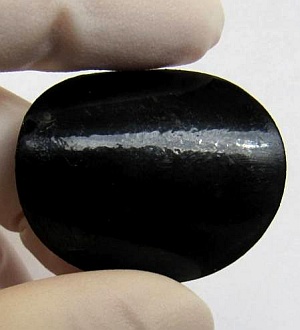|

04 July 2011
from
NatureAsia Website
|
Films of chemically derived
graphene layers separated by water show high performance
in supercapacitors. |

A photograph of a
hydrated graphene multilayer film
obtained from
chemically derived graphene
The exceptional thermal, electrical and
mechanical properties of
graphene make this single atomic layer of
carbon a promising material for a range of applications, including
energy storage.
The high specific area of graphene and
its unique electron transport properties make it particularly
suitable for use in supercapacitors, especially if the graphene can
be stacked into multiple separate layers.
Unfortunately, when stacked in this way,
graphene tends to form a graphite-like solid mass through strong
inter-sheet attractions, which severely compromises the useful
properties of the single graphene sheets.
Now, Dan Li and colleagues from
Monash University in Australia 1 have shown a
simple possible solution to the restacking problem: just keep
chemically derived graphene wet.
The team drew their conclusion from carefully examining the
formation of graphene ‘paper’, which is made by filtering graphene
suspended in water. They found that water trapped in as-filtrated
graphene paper can act as a spacer between the individual layers to
prevent restacking.
Li and his colleagues believe that because chemically derived
graphene sheets are corrugated, the contact area between two sheets
is much lower than if they were perfectly flat. In addition, the
hydration of graphene generates repulsive forces strong enough to
keep the graphene sheets well separated. The high specific surface
area of the graphene sheets can therefore be harnessed effectively
in a film form (pictured) suitable for integration into various
devices.
The layer separation due to water is very effective.
Li and his colleagues characterized the
electrochemical response of supercapacitors constructed using their
wet graphene films and observed a much higher capacitance that in
the case of dried films.
This enhanced capacitance was obtained
even at very high frequency, meaning that the charging and
discharging of the capacitor can occur at very high speed.
“Given the extraordinary
supercapacitor performance, ease of cost-effective and scalable
synthesis of such materials, our discovery will boost the
development of the next generation of ultrafast energy storage
devices”, says Li.
In addition to its great potential for
capacitive energy storage, the researchers believe that other
applications could also benefit from this bulk assembly, including,
-
battery electrodes
-
fuel cells
-
electrochemical sensors and
actuators
-
water purification membranes
-
even biomedical devices...
Reference
-
Yang, X, Zhu, J., Qiu, L. & Li,
D. Bioinspired effective prevention of restacking in
multilayered graphene films: towards the next generation of
high-performance supercapacitors. Adv. Mater. Published
online: 10 May 2011 | DOI: 10.1002/adma.201100261 |
article
Author affiliation
-
Department of Materials
Engineering, ARC Centre of Excellence for Electromaterials
Science, Monash University, VIC 3800, Australia
|

